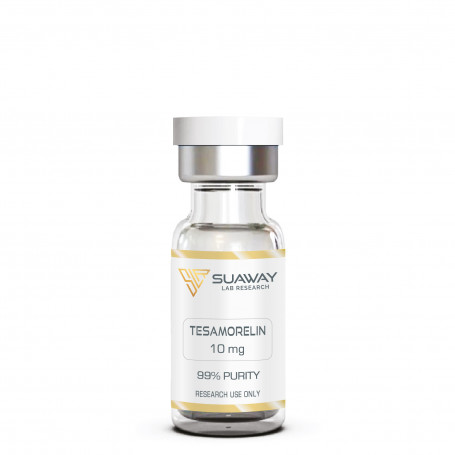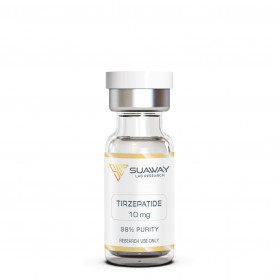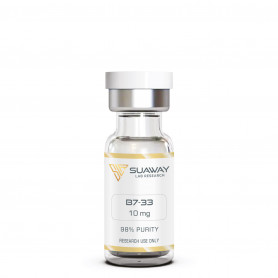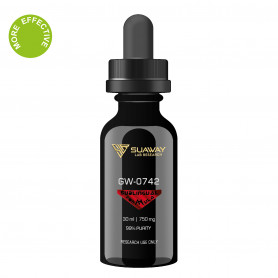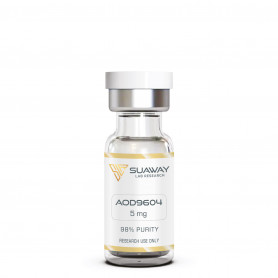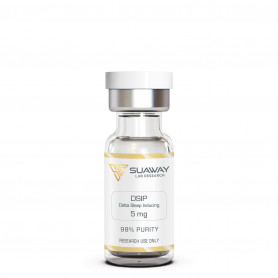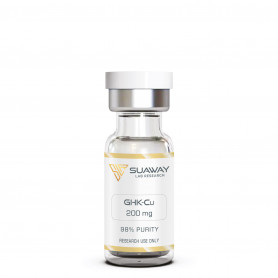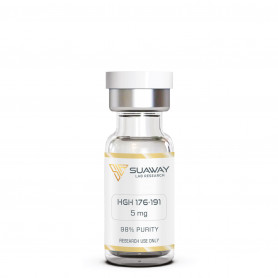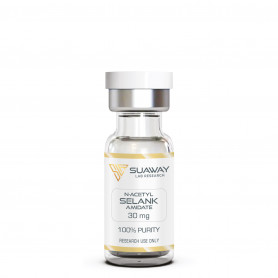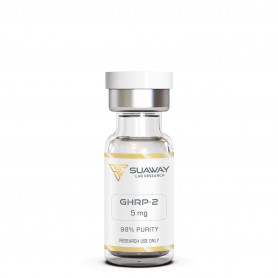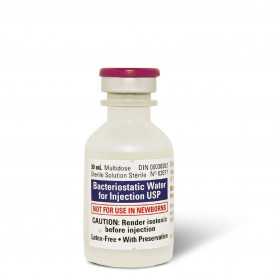TESAMORELIN - 10mg
Tesamorelin, is a growth-hormone-releasing hormone (GHRH) analogue.
Recent research and clinical trials have established that it has the following benefits:
- Increases natural productions of HGH (human growth hormone)
- Increases IGF-1 (Insulin Growth Factor – 1) without altering glucose parameters
- Reduced triglycerides
- Reduced Visceral Adipose Tissue (VAT)
- Reduced Carotid Intima Media Size (cIMT)
- Improved cognition in adults over the age of 60
- Anti-aging effects
- Restoring Growth Hormone
- Preserving Lean Muscle Mass
Tesamorelin is now being tested in clinical trials for the treatment of HIV-associated lipodystrophy. (Lipodystrophy is characterized by excessive accumulation of fat not just in the abdominal region but also in other parts of the body.)
It is also being researched for its ability to improve peripheral nerve health and slow the progression of mild cognitive impairment/dementia.
Description
STRUCTURE
Sequence: Trans-3-Hexenoyl-Tyr-Ala-Asp-Ala-Ile-Phe-Thr-Asn-Ser-Tyr-Arg-Lys-Val-Leu-Gly-Gln-Leu-Ser-Ala-Arg-Lys-Leu-Leu-Gln-Asp-Ile-Met-Ser-Arg-Gln-Gln-Gly-Glu-Ser-Asn-Gln-Glu-Arg-Gly-Ala-Arg-Ala-Arg-Leu-NH2
Molecular Formula: C221H366N72O67S
Molecular Weight: 5135.9 g/mol
PubChem CID: 44147413
CAS Number: 901758-09-6
Peptide purity: greater than 98%
Other details: No TFA Salt, No Mannitol
Storage: Lyophilized peptide must be stored at -20°C and peptide solution at 4°C.
Tesamorelin has low oral and excellent subcutaneous bioavailability.
DESCRIPTION
Tesamorelin, which acts as a GHRH analog, has all of the same effects as GHRH and other GHRH analogs, such as sermorelin, GRF (1-29), CJC-1295, and so on. Tesamorelin is rendered more stable in human plasma after being combined with trans-3-hexanoic acid, which increases the compound's half-life. Tesamorelin, like CJC-1295, maintains the physiological activity of GHRH and, as a result, has fewer negative effects than comparable compounds that eliminate normal pulsatile growth hormone (GH) release.
The body suffers from a lack of hormones as individuals age, which are essential for numerous basic activities. In addition, if older persons do not engage in enough physical activity, they are more likely to gain fat around the abdominal region while simultaneously losing a significant amount of muscle mass annually. One of the negative effects of becoming older is a reduction in cognitive function, which makes it impossible for elderly individuals to operate at the same level as younger ones.
Because of this, tesamorelin is now being researched for potential use in peptide therapy, to assist the elderly population in maintaining a higher quality of life.
Tesamorelin is a growth hormone-releasing hormone (GHRH) analog, as was just described in the previous paragraph. To put it another way, the introduction of tesamorelin into the body may cause a rise in growth hormone to occur as a result of a chain reaction, which can extend the life and revive young health.
The pituitary gland is responsible for the production of human growth hormone. It has a substantial impact on a wide variety of physiological processes, including the typical development of children, the control of body composition, the growth of muscle and bone, the metabolism of sugar and fat, and the operation of the heart. A synthetic peptide that can enhance growth hormone levels may be able to reverse the age-related decline that occurs naturally in the body of humans. Growth hormone levels normally decline with advancing age. Because of this, it is anticipated that tesamorelin will have a beneficial effect on anti-aging and lifespan.
Restoring Growth Hormone
The production of growth hormones gradually decreases with advancing age, which, among many other hormones, contributes to a variety of age-related health issues. This category of geriatric diseases includes both a rise in total body fat and a fall in the proportion of lean muscle mass to total body mass, as well as a decline in cognitive function. Tesamorelin works to bring back growth hormone levels to normal by first stimulating the pituitary gland, which then causes the pituitary gland to release GHRH. As a result, tesamorelin directly targets abdominal fat and cures age-related problems, as will be addressed further down in this article.
Reducing Visceral Fat
According to Research, tesamorelin may enhance growth hormone, which in turn may increase the rate at which visceral fat is burned for fuel. The process of breaking down fat stores into fatty acids, which are subsequently transformed into fuel for the body's many processes, is referred to as fat oxidation. In a nutshell, tesamorelin has the potential to assist in the mobilization of fat that is located around the abdominal organs to provide energy. Tesamorelin does not affect the subcutaneous fat tissue, which is a significant finding. This targeted decrease in fat is advantageous because it helps defend against or inhibits the worsening of improper distribution of fat into other organs. This is why selective fat loss is good.
Preserving Lean Muscle Mass
According to the findings of one study, treating people with growth hormone deficiency with growth hormone therapy may help them recover muscular strength. Younger people had more substantial benefits from the intervention than older people. Tesamorelin may enhance and normalize the amount of lean muscle mass in both young persons with growth hormone deficit and healthy older adults since it acts as a GHRH analog. Tesamorelin has been shown to have this effect.
Improving Cognitive Function
According to study, Tesamorelin may greatly increase the capacity of healthy older persons and those with minor cognitive impairment to remember words, solve problems, keep their focus, and develop plans. Tesamorelin also improved their ability to remember words. Tesamorelin may be beneficial for synaptic plasticity, which boosts mental ability. This is because it restores normal growth hormone levels. To investigate the possible effects of tesamorelin on brain health in the context of normal aging, however, a therapy that is administered for a longer time is required.
There is a possibility that the effects of tesamorelin will wear off after treatment with the peptide is finished. Therefore, using tesamorelin on a long-term basis for at least six months may be the most effective way to sustain excellent results.
Tesamorelin has been proven to decrease lipodystrophy in HIV-infected patients, and it has also been demonstrated to reduce abdominal fat in individuals who are not HIV-infected similarly.
According to the findings of one clinical study, individuals who were administered Tesamorelin had decreases in deep belly fat at a rate of 10.9 percent. These patients suffered from HIV. Throughout the research, participants saw decreases in their total body fat, waist circumference, and waist-to-hip ratios. The level of insulin-like growth factor 1 was increased while the patient was receiving Tesamorelin. However, glucose parameters were not affected. The majority of people who used this medication did not experience any unfavorable side effects. The whole duration of the trial was sixty weeks. Overall, there was an eighteen percent reduction in the amount of visceral fat.
People living with HIV have an elevated risk of developing cardiovascular disease (CVD), in part because of excessive fat deposition and in part because of the activities of antiretroviral medications themselves. Both of these factors contribute to the increased risk. After highly active antiretroviral treatment (HAART), the prevention of cardiovascular disease in HIV-positive patients is regarded to be the most significant medical intervention for long-term well-being
According to research conducted on HIV-positive individuals, tesamorelin, in addition to lowering levels of lipodystrophy, also lowers levels of triglycerides, total cholesterol, and non-HDL-C. Tesamorelin was shown to cause a drop of 15% in visceral adipose tissue, which was correlated with a decrease of 50 mg in trigylceride levels.
It is important to take note of the fact that inflammation is linked to ectopic fat accumulation, which may be seen in lipodystrophy. Inflammation of any form is considered to be a risk factor for cardiovascular disease. There is an independent link between visceral adipose tissue, fat in the liver, and epicardial fat with an elevated risk of cardiovascular disease (CVD). Tesamorelin directly reduces inflammation and an individual's risk of developing cardiovascular disease by lowering the amount of ectopic fat that is deposited in the body.
New research reveals that highly active antiretroviral therapy (HAART) is connected with a range of endocrine and metabolic issues, one of which is a lack of growth hormone (GH). It would seem that HIV infection causes changes to the pituitary gland; as a result, roughly one-third of HIV patients who are on HAART suffer from GH shortage. This may, to some part, explain why patients with HIV are at such a high risk for developing lipodystrophy, as well as why tesamorelin is such a successful therapy for the condition. Tesamorelin, as opposed to the administration of exogenous GH, is a method that is not only safer but also more successful in raising GH levels, especially in HIV-positive persons.
Damage to the nerves in the body's periphery might be the result of traumatic events, diabetes, or even surgical procedures. Because nerve cells are famously difficult to regenerate, it often results in significant issues with both motor and sensory function in the afflicted region. However, there is not much that can be done to rectify the condition because there is no known cure for it. However, research shows that treatments based on the modification of growth hormones may ameliorate peripheral nerve damage and boost both the pace and degree of recovery.
There is new evidence that GHRH analogs, such as tesamorelin, are beneficial in improving cognition in people who are in the early stages of dementia. These patients have been diagnosed with dementia. Tesamorelin and other GHRH analogs may impact dementia by increasing gamma-aminobutyric acid (GABA) levels in the brain and decreasing myo-insoitol (MI) levels, according to the findings of a large, randomized, double-blind, placebo-controlled study that was conducted at the University of Washington School of Medicine for twenty weeks. This study was carried out for twenty weeks.
Tesamorlein vs Ipamorlein
Tesamorelin and Ipamorelin are both examples of synthetic peptides that can stimulate the production of human growth hormones. Ipamorelin is a short peptide that has a rapid onset of action since it is composed of just five chains of amino acids. Tesamorelin is a peptide with a longer duration of activity since it has 44 amino acid chains.
One of the most notable distinctions between the two is that each one operates via a distinct physiological mechanism in the body. Tesamorelin affects the receptors that secrete growth hormone, while ipamorelin activates the receptors that secrete ghrelin. This indicates that the two peptides may be combined to get increased advantages from both of the routes.
REFERENCES
J. Falutz et al., "Effects of tesamorelin, a growth hormone-releasing factor, in HIV-infected patients with abdominal fat accumulation: a randomized placebo-controlled trial with a safety extension" [PubMed]
J. Falutz et al., "Effects of tesamorelin (TH9507), a growth hormone-releasing factor analog, in human immunodeficiency virus-infected patients with excess abdominal fat: a pooled analysis of two multicenter, double-blind placebo-controlled phase 3 trials with safety extension data" [PubMed]
S. Dhillon "Tesamorelin: a review of its use in the management of HIV-associated lipodystrophy" [PubMed]
J.E. Lake et al., "Tesamorelin improves fat quality independent of changes in fat quantity" [PubMed]
Bethesda "ìTesamorelin" [National Institute of Diabetes and Digestive and Kidney Diseases]
Y. Wang et al., "Tesamorelin, a human growth hormone releasing factor analogue" [PubMed]
J. Falutz et al., "Long-term safety and effects of tesamorelin, a growth hormone-releasing factor analogue, in HIV patients with abdominal fat accumulation" [PubMed]
B. Tomlinson "Drug evaluation: tesamorelin, a synthetic human growth hormone releasing factor" [PubMed]
S. Teng et al., "Impact of Tesamorelin, a Growth Hormone-Releasing Factor (GRF) Analogue, on the Pharmacokinetics of Simvastatin and Ritonavir in Healthy Volunteers" [PubMed]
T.L. Stanley et al., "Effect of tesamorelin on visceral fat and liver fat in HIV-infected patients with abdominal fat accumulation: a randomized clinical trial" [PubMed]
L.M. Spooner et al., "Tesamorelin: a growth hormone-releasing factor analogue for HIV-associated lipodystrophy" [PubMed]
S. Adrian et al., "The Growth Hormone Releasing Hormone Analogue, Tesamorelin, Decreases Muscle Fat and Increases Muscle Area in Adults with HIV" [PubMed]
H. Makimura et al., "The effects of tesamorelin on phosphocreatine recovery in obese subjects with reduced GH" [PubMed]
L.T. Fourman et al., "Visceral fat reduction with tesamorelin is associated with improved liver enzymes in HIV" [PubMed]
H. Makimura et al., "Metabolic Effects of a Growth Hormone-Releasing Factor in Obese Subjects with Reduced Growth Hormone Secretion: A Randomized Controlled Trial" [PubMed]
DISCLAIMER
This product is intendend for lab research and development use only. These studies are performed outside of the body. This product is not medicines or drugs and has not been approved by the FDA or EMA to prevent, treat or cure any medical condition, ailment or disease. Bodily introduction of any kind into humans or animals is strictly forbidden by law. This product should only be handled by licensed, qualified professionals.
All product information provided on this website is for informational and educational purposes only.

